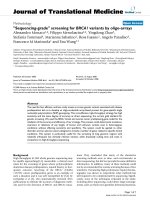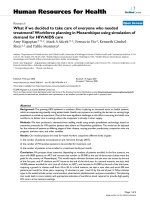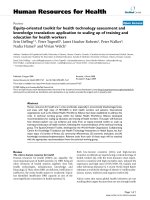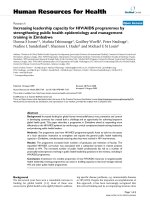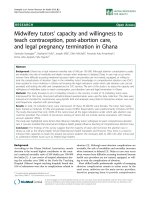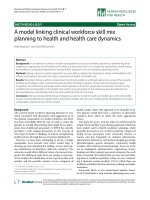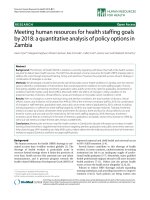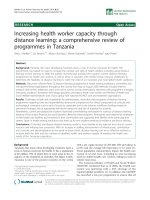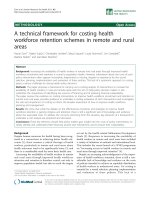báo cáo sinh học:" Increasing leadership capacity for HIV/AIDS programmes by strengthening public health epidemiology and management training in Zimbabwe" potx
Bạn đang xem bản rút gọn của tài liệu. Xem và tải ngay bản đầy đủ của tài liệu tại đây (214.77 KB, 8 trang )
BioMed Central
Page 1 of 8
(page number not for citation purposes)
Human Resources for Health
Open Access
Research
Increasing leadership capacity for HIV/AIDS programmes by
strengthening public health epidemiology and management
training in Zimbabwe
Donna S Jones*
1
, Mufuta Tshimanga
2
, Godfrey Woelk
3
, Peter Nsubuga
1
,
Nadine L Sunderland
4
, Shannon L Hader
5
and Michael E St Louis
6
Address:
1
Division of Global Public Health Capacity Development (previously Division of International Health), Centers for Disease Control and
Prevention, Atlanta, Georgia, USA,
2
MPH Programme, Department of Community Medicine, University of Zimbabwe Faculty of Medicine, Harare,
Zimbabwe,
3
RTI International, Research Triangle Park, North Carolina, USA,
4
Global AIDS Program, Centers for Disease Control and Prevention,
Atlanta, Georgia, USA,
5
HIV/AIDS Administration, DC Department of Health, Washington, DC, USA and
6
Coordinating Office for Global Health,
Centers for Disease Control and Prevention, Atlanta, Georgia, USA
Email: Donna S Jones* - ; Mufuta Tshimanga - ; Godfrey Woelk - ;
Peter Nsubuga - ; Nadine L Sunderland - ; Shannon L Hader - ; Michael E St
Louis -
* Corresponding author
Abstract
Background: Increased funding for global human immunodeficiency virus prevention and control
in developing countries has created both a challenge and an opportunity for achieving long-term
global health goals. This paper describes a programme in Zimbabwe aimed at responding more
effectively to the HIV/AIDS epidemic by reinforcing a critical competence-based training institution
and producing public health leaders.
Methods: The programme used new HIV/AIDS programme-specific funds to build on the assets
of a local education institution to strengthen and expand the general public health leadership
capacity in Zimbabwe, simultaneously ensuring that they were trained in HIV interventions.
Results: The programme increased both numbers of graduates and retention of faculty. The
expanded HIV/AIDS curriculum was associated with a substantial increase in trainee projects
related to HIV. The increased number of public health professionals has led to a number of
practically trained persons working in public health leadership positions in the ministry, including in
HIV/AIDS programmes.
Conclusion: Investment of a modest proportion of new HIV/AIDS resources in targeted public
health leadership training programmes can assist in building capacity to lead and manage national
HIV and other public health programmes.
Background
The last several years have seen a remarkable increase in
funding for global health [1-3]. Most of these new
resources for global health come tightly linked to address-
ing specific disease problems, e.g. immunizable diseases
or HIV/AIDS. Despite the important accomplishments of
this approach, it has been increasingly recognized that
this vertical funding and its accompanying structure does
Published: 10 August 2009
Human Resources for Health 2009, 7:69 doi:10.1186/1478-4491-7-69
Received: 28 March 2008
Accepted: 10 August 2009
This article is available from: />© 2009 Jones et al; licensee BioMed Central Ltd.
This is an Open Access article distributed under the terms of the Creative Commons Attribution License ( />),
which permits unrestricted use, distribution, and reproduction in any medium, provided the original work is properly cited.
Human Resources for Health 2009, 7:69 />Page 2 of 8
(page number not for citation purposes)
not automatically address and may worsen the underlying
issues that severely reduce the capacity to respond to each
disease [4-6]. The most critical constraint to effective
response is weakened infrastructure and systems of public
health. The rapid expansion of programmes in such con-
texts can easily lead to only short-term impacts and fur-
ther weakening of public health infrastructure [6].
Many of these new resources may be wasted if human
resource constraints are not addressed [7,8]. The clear
challenges facing the public health workforce, particularly
in developing countries, have been well documented [9-
11]. This is a critical component of the global human
resource crisis that is limiting the ability of the world to
respond effectively to health crises [2,5]. The HIV/AIDS
crisis in sub-Saharan Africa has exacerbated the problem,
both by increasing the magnitude of the health crises and
diminishing the number of available health workers
[2,5,12]. Countries applying to the Global Fund to Fight
AIDS, Tuberculosis and Malaria have consistently identi-
fied human resources as a top priority for health system
strengthening [6].
In difficult environments, where few trained persons
might be available, it has been very tempting for interna-
tional organizations to hire away well-trained persons
from national institutions for specific small projects, typ-
ically funded by nongovernmental organizations (NGOs)
[7,13]. Because of the great resources for HIV/AIDS, AIDS
programmes are perhaps at particular risk for this unin-
tended consequence. This may lead to a successful small
project but can inadvertently undermine the long-term
goals of capacity strengthening and institution building.
This has been especially true in the context of the HIV/
AIDS epidemic in developing countries [2,11,13,14]. This
problem has now been recognized and acknowledged by
the donor community and the countries, which increas-
ingly plan to better coordinate aid to support national
health systems rather than focusing exclusively on dis-
ease-specific priorities[15,16].
Zimbabwe is one of the countries most severely affected
by HIV/AIDS. The estimated HIV prevalence in 2003 was
reported at 24.6% [17]. In 2000, increased funds for
responding to the epidemic in Zimbabwe became availa-
ble through the United States Centers for Disease Control
and Prevention's (CDC) Global AIDS Program (GAP).
Like many countries, Zimbabwe faced the problem of
absorption capacity: limited capacity to translate new
financial resources into effective programmes.
In particular, the number of persons trained for leadership
and management of new HIV intervention programmes
was insufficient. Inadequate remuneration for public
health officials and faculty was leading to loss of staff, or
to staff working extra jobs to compensate for poor public
sector salaries, thus limiting time available both to per-
form public health tasks and train public health staff. A
related problem, as alluded to above, was "internal brain
drain" reflected by hiring of national public sector staff to
work on internationally funded HIV projects, further
draining the necessary coordinating capacity and infra-
structure [7,13].
Zimbabwe had long recognized the need for locally
trained public health professionals. A Masters in Public
Health (MPH) programme using the applied epidemiol-
ogy training programme model had been started in 1994
through support of the Public Health Schools without
Walls (PHSWOW) Programme of the Rockefeller Founda-
tion and has continued with support from CDC's Division
of Global Public Health Capacity Development
(DGPHCD) (formerly Division of International Health
(DIH) [10,18-20]. PHSWOWs were developed as partner-
ships between ministries of health and universities.
Applied epidemiology training programmes, also known
as field epidemiology training programs (FETP) are
designed to build human capacity in health service agen-
cies by providing training in field epidemiology and other
public health competences in the context of health service
delivery systems [18,21,22].
The Zimbabwe MPH programme began in 1993 as a joint
effort of the Ministry of Health and Child Welfare (MOH)
and the Department of Community Medicine at the Uni-
versity of Zimbabwe (UZ). A CDC advisor was resident in
Zimbabwe during 1994–1996. During 1994–2000, a total
of 41 trainees graduated. Most trainees were physicians
and nurses, but pharmacists, veterinarians, nutritionists,
laboratorians and other health staff were trained.
The programme was well respected and well integrated
into the public health system and the MOH, as indicated
by the fact that the majority of graduates were employed
within the national public health system at either
national-level positions in MOH, as Provincial Medical
Directors or as City Health Directors. However, with only
four to eight graduates per year, the number of public
health professionals still did not meet the country's needs.
In addition, the MPH curriculum in Zimbabwe had not
been updated in response to the emergence of the HIV/
AIDS crisis. Despite the >50% national burden of disease
attributable to HIV in Zimbabwe [23], the focus on HIV
was limited, with only three of 41 MPH dissertation topics
during 1994–2000 being HIV/AIDS-related.
When CDC GAP began to work in Zimbabwe in 2000,
despite 10 years of Zimbabwean research and reports on
HIV/AIDS, there was limited implementation of truly
nationwide HIV prevention and treatment programmes to
Human Resources for Health 2009, 7:69 />Page 3 of 8
(page number not for citation purposes)
slow the epidemic and attenuate its impact. CDC GAP,
together with the MOH, jointly developed specific goals
related to HIV prevention and control for Zimbabwe.
These included expansion of Prevention of Mother to
Child Transmission of HIV (PMTCT), expansion of HIV
testing capacity, improved understanding of the epidemic
through better surveillance methods, behavioural inter-
ventions, improvement of care for opportunistic infec-
tions and introduction of antiretrovirals (ARV)
throughout the country.
A key supporting strategy of CDC GAP was to build
human capacity and strengthen the existing health institu-
tions to provide the needed leadership in a sustainable
way. This paper describes one specific collaborative effort,
begun in 2001, that built on the strength and resources of
many partners to respond more effectively to the HIV/
AIDS epidemic by reinforcing a crucial training institution
and thereby expanding production of epidemiologists
and public health leaders.
Methods
Programme description
CDC GAP provided financial resources for a broad array
of national HIV/AIDS programmes, including extensive
in-country technical support. The University of Zimba-
bwe, Department of Community Medicine, already had
faculty members and experience with running a successful
field training-based MPH programme. The MOH had
been providing the province-level posts and first-line
mentorship during the critical field training period. In
addition, and probably most important, the MOH was the
major employer of MPH graduates, recruiting them into
positions of responsibility and establishing this training
programme as its main career-development conduit for
senior public health leaders and managers. The Division
of Global Public Health Capacity Development
(DGPHCD) at CDC had long partnered with the UZ/MPH
programme and had substantial experience in supporting
applied epidemiology training in many other countries.
The partners shared a vision that programmatic HIV pre-
vention and care goals could be met by strengthening
public health systems and supporting specific areas of
national human capacity development rather than by nar-
rowly addressing only HIV programmatic needs.
This collaboration developed a number of goals for the
programme:
• Strengthen the public health leadership training pro-
gramme and increase its output.
• Increase the focus on training to produce public
health leaders explicitly equipped to design and
implement HIV intervention programmes.
• Increase the number of HIV and related positions in
the MOH filled by programme graduates.
• Increase the informatics capacity of the public health
training system to meet HIV/AIDS information
requirements while using an approach that had broad
applicability to public health in Zimbabwe.
Interventions to strengthen the MPH programme
included a faculty-run curriculum review with technical
support from CDC/DGPHCD to ensure that course objec-
tives addressed the needed topics and received adequate
focus in the training. Faculty training was provided, both
locally and internationally. Modest financial assistance to
support retention was provided to departmental faculty
working in the MPH programme in return for quality
training and mentoring of trainees (difficult to estimate
precisely because of currency fluctuations, but represent-
ing less than 5% of faculty support). Support was pro-
vided both to increase the number of trainees and to
improve trainee resources, including computers, text-
books and housing.
A local expatriate technical advisor was hired to assist with
teaching and curriculum development and to provide
additional technical support for trainees' field projects. An
assistant field coordinator, a graduate of the MPH pro-
gramme, was added to assist in teaching and trainee sup-
port and to assist in trainee recruitment. Efforts to increase
the number of trainees included providing more resources
and increasing recruitment among health professionals by
the newly hired staff.
Expansion of HIV/AIDS training in the curriculum was
addressed by collaborating with many of the persons and
agencies involved in HIV/AIDS in the country to create an
HIV interventions course tailored to Zimbabwe's situa-
tion. National leaders from major HIV-related pro-
grammes lectured trainees. Exercises were conducted to
place trainees in the position of designing appropriate
HIV interventions based on local data and in the context
of Zimbabwe's actual programme constraints and oppor-
tunities. As a resource for trainees to use during and after
the course, all core national HIV/AIDS policy, strategy and
programme documents were collected and put on a CD-
ROM for trainees.
The trainees in applied epidemiology spend 14 months in
the field applying the public health lessons they have
learnt during their classroom instruction. They are
required to complete five service learning activities at their
field site. The topics addressed by the trainees are chosen
based on local priorities. They are expected to apply the
knowledge and skills from the HIV course to local issues
in the provinces and cities where they conduct their field
work.
Human Resources for Health 2009, 7:69 />Page 4 of 8
(page number not for citation purposes)
The expansion of computer training and capacity in the
MPH programme, the university and the MOH was
accomplished through a number of activities. Funds were
provided to ensure that each MPH trainee had a laptop
computer. Computer training was provided to MPH train-
ees and others by means of a newly created training lab
with 36 computer stations. E-mail access was expanded so
that all provinces had access to e-mail through a toll-free
number without requiring Internet browser access. In
addition, the e-mail programme was improved so attach-
ments could be mailed easily, something that had been
very difficult in the past.
Results
CDC committed approximately USD 400 000/year to this
programme, or approximately 5% of its then USD 8 mil-
lion annual budget for Zimbabwe. The level of support
remained relatively constant for the years encompassed by
this manuscript (2001–2006). In the nearly six years since
the programme began, several important changes and
indicators support the success of the programme. Table 1
summarizes these changes.
Goal 1. Strengthen the public health leadership training
programme and increase its output
The curriculum review led to restructuring of the epidemi-
ology course and clarifying of course objectives. A CD-
ROM was created for the course lectures and teaching
materials to serve as a resource for trainees and faculty.
Since the strengthening process began, an increased
number of trainee projects have been accepted for presen-
tation at international conferences. In the first eight years
of the programme, five papers had been accepted for pres-
entation at the CDC Epidemic Intelligence Service Confer-
ence. In the past four years, seven papers have been
presented. Also, at least eight manuscripts from trainees
are being prepared or have been submitted for publica-
tion from the last three years, compared with one for the
three years preceding this programme. In addition,
whereas most trainee work had previously been published
only in regional journals, manuscripts are now being sub-
mitted to international journals.
Associated with the difficult economic climate in Zimba-
bwe, overall in the Faculty of Medicine at UZ, as of June
2004, only 133 (43%) of 307 available positions were
filled, primarily due to the departure of staff from Zimba-
bwe. In contrast, the faculty staffing in the Department of
Community Medicine had nearly a full complement, with
13 (76%) of 17 posts filled. The number of trainees grad-
uating from the programme has increased since the inter-
vention (Table 2).
Goal 2. Increase the focus on training to produce public
health leaders explicitly equipped to design and
implement HIV intervention programmes
A one-week HIV/AIDS course (Responding to the Epi-
demic) was created and was delivered to the MPH trainees
beginning in 2002. The course goals were to provide prac-
tical knowledge about key evidence-based technical strat-
egies for HIV prevention and care, orientation to key
national frameworks for response to HIV/AIDS, an assess-
ment of the HIV/AIDS situation, and skills in monitoring
and evaluation of HIV/AIDS interventions. Ultimately,
the course aimed to empower trainees to help implement
Table 1: Goals and achievement of an intervention to strengthen epidemiological and public health leadership training in the
Zimbabwe Field Epidemiology Training Programme, 2001–2006
Goals Status: pre-intervention Status: post-intervention
Strengthen the public health leadership training
programme and increase its output
Curriculum linked to faculty availability
4–8 graduates/year
Revised, standardized curriculum with
electronic materials available to faculty and
students
10–16 graduates/year (see Table 2)
Increase the focus on training for HIV
intervention programmes
No HIV-specific course
Few HIV-specific projects
1-week-long course "Responding to HIV"
Increased number and proportion of HIV
projects (see Table 3)
Increase the number of HIV and related
positions in the MOH filled by programme
graduates
3 HIV-related positions in MOH filled by
graduates
2 HIV-related positions outside MOH held by
graduates
7 HIV-related positions in MOH filled by
graduates
4 HIV-related positions outside MOH held by
graduates (as of 2005)
Increase the informatics capacity of the public
health training system
Limited Internet outside the capital city
Critique of field assignees work through postal
shipment of hardcopy comments
Regular email and Internet at Provincial Medical
Directorates
Establishment of computer training lab
Critique of field assignees work through Track
Changes in emailed attachments
Human Resources for Health 2009, 7:69 />Page 5 of 8
(page number not for citation purposes)
and manage health-sector interventions for HIV/AIDS.
The one-week HIV course has now been incorporated as a
standard part of the MPH curriculum.
Evaluation after the first year led to greater involvement of
the trainees' field supervisors. For the second and subse-
quent years, the field supervisors were oriented to the
training; several supervisors (all Provincial Medical Direc-
tors) were asked to participate in the planning and presen-
tation of the HIV course for the trainees.
The resource CD created for the HIV course incorporating
a number of review and reference materials was well
received and used. In the six-month post-course evalua-
tion, approximately 80% (19 of 23) of the trainees
reported using these materials in their field assignments
for teaching in provincial and district level courses and in
the community, and to provide reference material for pro-
vincial and district projects on various HIV interventions.
During the three years since the course began, there has
been a substantial increase in the number of HIV-related
trainee projects (Table 3). However, the great majority
(>80%) of projects still are drawn from the full range of
non-HIV/AIDS topics, so that the increased focus on AIDS
has not resulted in a restricted scope for the exposure of
trainees.
During 1993–2000, of 41 MPH dissertation projects com-
pleted, three (7%) were HIV-related. From 2001–2004, 13
(34%) of 38 dissertation topics studied HIV-related pro-
grammes. Examples of other HIV-related trainee projects
and their impact on policy and practice in Zimbabwe
include:
• a study of infant feeding among HIV-positive moth-
ers in 2003 that led to increased training in feeding
counselling for PMTCT staff;
• an evaluation of a commercial sex worker (CSW)
peer education programme in 2003 that led to pro-
gramme expansion and the development of a new Sex-
ually Transmitted Infection clinic for CSWs in
Chinoyi;
• a study on treatment outcomes for patients on
antiretroviral therapy (ART) in Bulawayo 2004 that
demonstrated favourable outcomes among patients
on ART and high adherence levels;
• a study of adverse events and adherence to Highly
Active Antiretroviral Therapy (HAART) in Harare that
led to clinicians' adopting a modified form of the
ACTG grading system on adverse events to guide them
in managing adverse events and to switch therapy as
appropriate;
• a study on factors associated with non-adherence to
HAART in Harare, 2006, that facilitated the opening
up of dialogue on coordination of activities by private
doctors and the city health doctors concerning ART.
Goal 3. Increase the number of HIV and related positions
in the MOH filled by programme graduates
The expansion of HIV resources, from both the CDC GAP
programme and other programmes, public and private,
has created a number of positions that require well-
trained public health professionals prepared to develop,
run and evaluate HIV/AIDS-intervention programmes.
Graduates from the MPH programme have been hired for
a number of these positions. As of September 2005, HIV/
AIDS-related positions in the MOH filled by MPH gradu-
ates include Director, National Department of Disease
Prevention and Control; Director, PMTCT Programme;
Table 2: Number of trainees in University of Zimbabwe MPH
programme, by year
Intake years Number of trainees
1993–1994 8
1995–1996 12
1997–1998 13
1999–2000 13
2001–2002 17
2003–2004 25
2005–2006 23
Table 3: Number and proportion of trainee HIV-related field projects before and after HIV course intervention
Intake years Trainees Total field projects HIV-related project (%) Percent of trainees with at least one HIV-related
project
1993–2001 46 241 8 (3.3%) 13%
2002–2004 38 190 26 (13.7%) 58%
Human Resources for Health 2009, 7:69 />Page 6 of 8
(page number not for citation purposes)
Director, ARV Treatment Programme; TB Manager, AIDS
and TB Unit; Workplace Officer, AIDS and TB Unit; Train-
ing Officer, AIDS and TB Unit; and ANC Surveillance
Officer.
MPH graduates in HIV/AIDS positions with other organi-
zations include WHO HIV/AIDS Officer for Zimbabwe;
the lead programme officer for HIV Care at United States
CDC in Zimbabwe; the Senior Technical Officer for
USAID's ARV Treatment Program; and programme officer
for HIV projects at UZ-UCSF Research Program. Training
in this programme has made the graduates attractive for
both MOH positions as well as other public health posi-
tions in the country; 30 of 35 recent graduates (2000–
2003) are employed in public health positions in Zimba-
bwe.
Goal 4. Increase the informatics capacity of the public
health training system to meet HIV/AIDS strategic
information requirements while using an approach that
has broad applicability to public health in Zimbabwe
The computer laboratory has been established and used to
teach EpiInfo [24]; the WHO HIV/AIDS Epidemic Projec-
tion Package [25]; the International Computer Drivers
License [26]; and other software packages to MPH train-
ees, faculty, Ministry staff and other persons. The expan-
sion of e-mail access to all provinces and the easy use of
attachments have greatly facilitated the interaction of
trainees in the field with faculty supervisors assisting with
their applied learning and research projects. This has
allowed rapid feedback to trainees on their proposals,
assistance with data analysis through sharing of data files,
and assistance with manuscript preparation, predomi-
nantly through the Track-Changes features of word-
processing software.
In the past, trainees often had to wait for the regular mail
system to send and receive hardcopy comments on their
fieldwork. In addition, the strengthening of the telecom-
munications infrastructure (especially more reliable and
efficient e-mail) has facilitated the ongoing technical sup-
port for the trainees from an expatriate technical advisor
who is no longer resident and has substantially improved
communication with other technical experts outside Zim-
babwe. Moreover, because this strengthened communica-
tion capacity now exists at provincial health departments
where the trainees' core field training takes place, it has
directly facilitated expansion of HIV programmes by sup-
porting distance-based technical support for HIV preven-
tion and treatment programmes and sharing of files and
reports for monitoring and evaluation.
Discussion
This programme demonstrates the ability of the CDC Glo-
bal AIDS Program in Zimbabwe to invest a relatively small
proportion of its HIV programme-specific funds to effec-
tively and substantially help to expand the public health
leadership in key positions. Moreover, rather than create a
detached HIV training programme, CDC GAP collabo-
rated with multiple partners to strengthen an existing crit-
ical component of the public health capacity-building
system that in turn directly assists the MOH and CDC to
meet HIV-specific programme goals. The key element of
this vision was the appreciation that achieving HIV/AIDS
programme goals could be realized through catalytic sup-
port of general public health leadership capacity develop-
ment, and did not require narrow HIV-specific training
programmes.
We are not able to attribute the rise in HIV-related trainee
projects solely to the increased HIV coursework. The
number of projects also increased at a time of increased
HIV resources and activities in the public health sector.
However, this is exactly the type of outcome desired, as
the curriculum was designed to reflect the actual health
priorities and burden of disease in the country. This pro-
gramme thus addresses the identified need to develop
public health curricula that reflect the emerging needs of
the health system where the trainees will work after train-
ing [8].
Much of the strength and effectiveness of the programme
comes from the fact that others had invested in public
health capacity strengthening several years before [10,27].
The existence of the public health training programme
and its integration into the public health infrastructure
allowed the new resources to strengthen and expand the
system for a more rapid and widespread effect. Reinforc-
ing existing and fundamental local institutions, rather
than developing a parallel system to train HIV programme
leaders, is likewise an important strategy for promoting
long-term sustainability.
Many persons who leave developing countries for higher
education programmes do not return to their country of
origin [28]. In-country, applied training programmes
both keep dedicated, trained health workers in the coun-
try and allow trainees to contribute immediately and pro-
ductively to important public health issues while still in
training and in formal mentoring [10,19,21,22].
Programme evaluations have found that trainees and
graduates of applied epidemiology training programmes
form solid networks in the country's health systems, with
the majority of them remaining in public health in their
home countries [18,20,22,29]. A recent review of the Cen-
tral American FETP demonstrated the same high level of
retention and placement of graduates in public health
leadership positions [30].
Human Resources for Health 2009, 7:69 />Page 7 of 8
(page number not for citation purposes)
Given the current economic and political difficulties in
Zimbabwe [31-33], retaining well-trained staff is a serious
concern. However, this programme has documented its
capacity to help train new public health leaders who are
already experienced in working on in-country problems
and programmes and – judging from the retention rates
observed – who appear committed to staying.
The higher retention of faculty for the programme com-
pared with the other departments in the Faculty of Medi-
cine may be partially related to the modest support and
training provided, but could also be related to differential
external opportunities for the non-clinical faculty in the
Department of Community Medicine. These resources are
no longer being provided and may not be crucial to pro-
gramme success.
Evaluation of similar programmes has shown that the
managers and decision-makers report numerous exam-
ples of how information from trainees and graduates was
valuable to them in designing and implementing health
programmes, e.g. introducing rubella vaccine and hepati-
tis B vaccination programmes in Thailand after FETP
investigations [29]. The success of the programme in Zim-
babwe and similar programmes has led to renewed inter-
est in developing similar programmes across Africa [21].
New field epidemiology training programmes are now
being developed in Ethiopia, Nigeria, South Africa, Tanza-
nia and in western Africa. These are being supported in a
similar fashion with "vertical" (mostly HIV/AIDS and
pandemic influenza) funding. They are using vertical
funding sources to produce disease-specific results while
also contributing "horizontally" to overall public health
system strengthening by building capable public health
leaders, adopting the so-called diagonal approach [34].
Conclusion
This report provides an example of how investment of a
modest proportion of new HIV/AIDS resources in targeted
public health leadership training programmes can assist
in building human capacity to lead and manage national
HIV and other public health programmes.
As donors seek to expand programmes to address global
disease concerns, including the HIV epidemic, access to
well-trained staff and supportive and collaborative minis-
try officials will be essential. Investment in well-trained
staff and emerging programme leaders will be essential to
addressing absorption capacity for the medium term
while also addressing short-term emergency needs. This
model of linking public health leadership capacity build-
ing to the HIV/AIDS programme goals provides one
example for intervention in this area.
Competing interests
The authors declare that they have no competing interests.
Authors' contributions
The paper was conceived by DJ and written with participa-
tion from all authors. The original project was conceived
by MSL, PN and MT. GW, SH and NS, together with all the
other authors, participated in the programme implemen-
tation and management. All authors have reviewed and
commented on drafts, and have seen and approved the
final version.
Authors' information
DJ is a Medical Epidemiologist, Division of Global Public
Health Capacity Development (previously Division of
International Health), CDC. MT is Field Coordinator,
MPH Programme, Department of Community Medicine,
University of Zimbabwe Faculty of Medicine. GW is a Sen-
ior Research Epidemiologist, RTI International (formerly
Chairman, Department of Community Medicine, Univer-
sity of Zimbabwe Faculty of Medicine). PN is a Medical
Epidemiologist, Division of Global Public Health Capac-
ity Development (previously Division of International
Health), CDC. NS is a Health Communication Specialist,
Global AIDS Program, CDC. SH is Senior Deputy Direc-
tor, HIV/AIDS Administration (formerly Director, CDC
Zimbabwe). MSL is a Senior Science Officer, Coordinating
Office for Global Health, CDC (formerly Director, CDC
Zimbabwe).
Acknowledgements
The authors gratefully acknowledge the vision and support of Mark White;
Mark Fussell for leadership in operations support and management; Davies
Dhlakama for spearheading support within the Ministry of Health and Child
Welfare (MOHCW); and all the faculty and staff in the University of Zim-
babwe Department of Community Medicine and the MOHCW Health
Studies Office for their many and diverse contributions.
References
1. Ravishankar N, Gubbins P, Cooley RJ, Leach-Kemon K, Michaud CM,
Jamison DT, Murray CJL: Financing of global health: tracking
development assistance for health from 1990 to 2007. Lancet
2009, 373:2113-2124.
2. Narasimhan V, Brown H, Pablos-Mendez A, Adams O, Dussault G,
Elzinga G, Nordstrom A, Habte D, Jacobs M, Solimano G,
Sewankambo N, Wibulpolprasert S, Evans T, Chen L: Responding
to the global human resources crisis. Lancet 2004,
363:1469-1472.
3. Schieber GJ, Gottret P, Fleisher LK, Leive AA: Financing Global
Health: Mission Unaccomplished. Health affairs 2007, 26:921.
4. Beaglehole R, Bonita R, Horton R, Adams O, McKee M: Public
health in the new era: improving health through collective
action. Lancet 2004, 363:2084-2086.
5. Chen L, Evans T, Anand S, Boufford JI, Brown H, Chowdhury M,
Cueto M, Dare L, Dussault G, Elzinga G, Fee E, Habte D, Hanvo-
ravongchai P, Jacobs M, Kurowski C, Michael S, Pablos-Mendez A,
Sewankambo N, Solimana G, Stilwell B, de Waal A, Wibulpolprasert
S: Human resources for health: overcoming the crisis. Lancet
2004, 364:1984-1990.
6. Drager S, Gedik G, Dal Poz MR: Health workforce issues and the
Global Fund to fight AIDS, Tuberculosis and Malaria: an ana-
lytical review. Hum Resour Health 2006, 4:23.
7. Davey G, Fekade D, Parry E: Must aid hinder attempts to reach
the Millennium Development Goals? Lancet 2006, 367:629-631.
8. World Health Organization: The World Health Report 2006:
Working Together for Health. Geneva 2006.
Publish with BioMed Central and every
scientist can read your work free of charge
"BioMed Central will be the most significant development for
disseminating the results of biomedical research in our lifetime."
Sir Paul Nurse, Cancer Research UK
Your research papers will be:
available free of charge to the entire biomedical community
peer reviewed and published immediately upon acceptance
cited in PubMed and archived on PubMed Central
yours — you keep the copyright
Submit your manuscript here:
/>BioMedcentral
Human Resources for Health 2009, 7:69 />Page 8 of 8
(page number not for citation purposes)
9. Beaglehole R, Dal Poz MR: Public health workforce: challenges
and policy issues. Hum Resour Health 2003, 1:4.
10. Beaglehole R, Sanders D, Dal Poz M: The public health workforce
in sub-Saharan Africa: challenges and opportunities. Ethn Dis
2003, 13:S24-S30.
11. Haines A, Sanders D: Building capacity to attain the Millennium
Development Goals. Trans R Soc Trop Med Hyg 2005, 99:721-726.
12. Work ILOPoHAatWo: HIV/AIDS and work global estimates, impact and
response Geneva: ILO Programme on HIV/AIDS and the World of
Work; 2004.
13. Kushner AL, Mannion SJ, Muyco AP: Secondary crisis in African
health care. Lancet 2004, 363:1478.
14. Estimating the resource needs of scaling-up HIV/AIDS and
tuberculosis interventions in sub-Saharan Africa: a system-
atic review for national policy makers and planners. Health
Policy 2006, 79:1-15. Epub 2006 Jan 2004
15. The International Health Partnership Launched Today
[ />national-Health-Partnership-Launched-Today/]
16. Reich MR, Takemi K, Roberts MJ, Hsiao WC: Global action on
health systems: a proposal for the Toyako G8 summit. Lancet
2008, 371:865-869.
17. Government of Zimbabwe: Zimbabwe National HIV and AIDS Estimates,
2003 Harare: Ministry of Health and Child Welfare, Health Informa-
tion and Surveillance Unit, Department of Disease Prevention and
Control, AIDS & TB Programme; 2003.
18. White ME, McDonnell SM, Werker DH, Cardenas VM, Thacker SB:
Partnerships in international applied epidemiology training
and service, 1975–2001. Am J Epidemiol 2001, 154:993-999.
19. Petrakova A, Sadana R: Round table – Problems and progress in
public health education. Bull World Health Organ 2007, 85:963.
20. Beaglehole R, Luca A, Matchaba R, Muli-Musiime F: Enhancing Public
Health in Developing Countries: A Report to the Rockefeller Foundation
New York: Rockefeller Foundation; 2001.
21. Nsubuga P, White M, Fontaine R, Simone P: Training programmes
for field epidemiology. Lancet 2008, 371:630-631.
22. Wang Y, Zeng G, Fontaine RE: China building teams to tackle
public health crises. Nature 2005, 436:626.
23. Chapman G, Hansen KS, Jelsma J, Ndhlovu C, Piotti B, Byskov J, Vos
T: The burden of disease in Zimbabwe in 1997 as measured
by disability-adjusted life years lost. Tropical Medicine & Interna-
tional Health 2006, 11:660-671.
24. Centers for Disease Control and P: EpiInfo 2002. Atlanta: The
Centers for Disease Control and Prevention; 2001.
25. Ghys PD, Brown T, Grassly NC, Garnett G, Stanecki KA, Stover J,
Walker N: The UNAIDS Estimation and Projection Package:
A software package to estimate and project national HIV
epidemics. Sexually transmitted infections 2004, 80:I5.
26. International Computer Driver's License: Computer competence
certified. Information retrieval & library automation 2002, 37:1.
27. Sadana R, Chowdhury AM, Chowdhury R, Petrakova A: Strength-
ening public health education and training to improve global
health. Bull World Health Organ 2007, 85:163.
28. Saravia NG, Miranda JF:
Plumbing the brain drain. Bull World
Health Organ 2004, 82:608-615.
29. Betts CD: Final Report on Evaluation of the Field Epidemiology Training
Program (FETP) Arlington, Va.: Battelle; 1998.
30. Lopez A, Caceres VM: Central America Field Epidemiology
Training Program (CA FETP): a pathway to sustainable pub-
lic health capacity development. Hum Resour Health 2008, 6:27.
31. HIV and AIDS in Zimbabwe [ />bwe.htm]
32. Koenig R: Science in Zimbabwe. Researchers struggle to
adapt to economic, political turmoil. Science (New York, NY)
2007, 316:684-685.
33. Kapp C: Health crisis worsens in Zimbabwe. Lancet 2007,
369:1987-1988.
34. Sepulveda J, Bustreo F, Tapia R, Rivera J, Lozano R, Olaiz G, Partida
V, Garcia-Garcia L, Valdespino JL: Improvement of child survival
in Mexico: the diagonal approach. Lancet 2006, 368:2017-2027.
